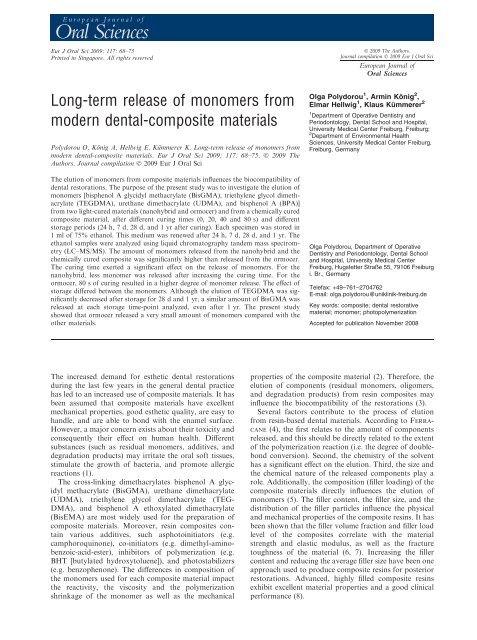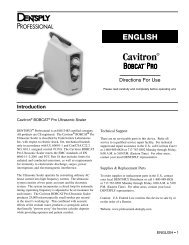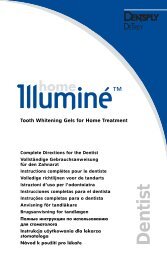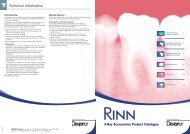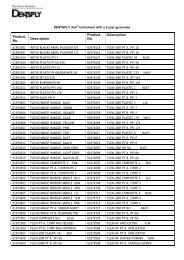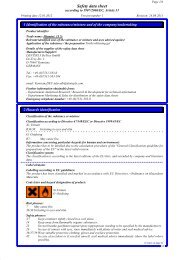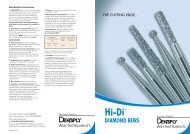Long-term release of monomers from modern dental ... - Dentsply
Long-term release of monomers from modern dental ... - Dentsply
Long-term release of monomers from modern dental ... - Dentsply
You also want an ePaper? Increase the reach of your titles
YUMPU automatically turns print PDFs into web optimized ePapers that Google loves.
Eur J Oral Sci 2009; 117: 68–75<br />
Printed in Singapore. All rights reserved<br />
<strong>Long</strong>-<strong>term</strong> <strong>release</strong> <strong>of</strong> <strong>monomers</strong> <strong>from</strong><br />
<strong>modern</strong> <strong>dental</strong>-composite materials<br />
Polydorou O, Ko¨nig A, Hellwig E, Ku¨mmerer K. <strong>Long</strong>-<strong>term</strong> <strong>release</strong> <strong>of</strong> <strong>monomers</strong> <strong>from</strong><br />
<strong>modern</strong> <strong>dental</strong>-composite materials. Eur J Oral Sci 2009; 117: 68–75. Ó 2009 The<br />
Authors. Journal compilation Ó 2009 Eur J Oral Sci<br />
The elution <strong>of</strong> <strong>monomers</strong> <strong>from</strong> composite materials influences the biocompatibility <strong>of</strong><br />
<strong>dental</strong> restorations. The purpose <strong>of</strong> the present study was to investigate the elution <strong>of</strong><br />
<strong>monomers</strong> [bisphenol A glycidyl methacrylate (BisGMA), triethylene glycol dimethacrylate<br />
(TEGDMA), urethane dimethacrylate (UDMA), and bisphenol A (BPA)]<br />
<strong>from</strong> two light-cured materials (nanohybrid and ormocer) and <strong>from</strong> a chemically cured<br />
composite material, after different curing times (0, 20, 40 and 80 s) and different<br />
storage periods (24 h, 7 d, 28 d, and 1 yr after curing). Each specimen was stored in<br />
1 ml <strong>of</strong> 75% ethanol. This medium was renewed after 24 h, 7 d, 28 d, and 1 yr. The<br />
ethanol samples were analyzed using liquid chromatography tandem mass spectrometry<br />
(LC–MS/MS). The amount <strong>of</strong> <strong>monomers</strong> <strong>release</strong>d <strong>from</strong> the nanohybrid and the<br />
chemically cured composite was significantly higher than <strong>release</strong>d <strong>from</strong> the ormocer.<br />
The curing time exerted a significant effect on the <strong>release</strong> <strong>of</strong> <strong>monomers</strong>. For the<br />
nanohybrid, less monomer was <strong>release</strong>d after increasing the curing time. For the<br />
ormocer, 80 s <strong>of</strong> curing resulted in a higher degree <strong>of</strong> monomer <strong>release</strong>. The effect <strong>of</strong><br />
storage differed between the <strong>monomers</strong>. Although the elution <strong>of</strong> TEGDMA was significantly<br />
decreased after storage for 28 d and 1 yr, a similar amount <strong>of</strong> BisGMA was<br />
<strong>release</strong>d at each storage time-point analyzed, even after 1 yr. The present study<br />
showed that ormocer <strong>release</strong>d a very small amount <strong>of</strong> <strong>monomers</strong> compared with the<br />
other materials.<br />
Ó 2009 The Authors.<br />
Journal compilation Ó 2009 Eur J Oral Sci<br />
European Journal <strong>of</strong><br />
Oral Sciences<br />
Olga Polydorou 1 , Armin Kçnig 2 ,<br />
Elmar Hellwig 1 , Klaus Kümmerer 2<br />
1 Department <strong>of</strong> Operative Dentistry and<br />
Periodontology, Dental School and Hospital,<br />
University Medical Center Freiburg, Freiburg;<br />
2 Department <strong>of</strong> Environmental Health<br />
Sciences, University Medical Center Freiburg,<br />
Freiburg, Germany<br />
Olga Polydorou, Department <strong>of</strong> Operative<br />
Dentistry and Periodontology, Dental School<br />
and Hospital, University Medical Center<br />
Freiburg, Hugstetter Straße 55, 79106 Freiburg<br />
i. Br., Germany<br />
Telefax: +49–761–2704762<br />
E-mail: olga.polydorou@uniklinik-freiburg.de<br />
Key words: composite; <strong>dental</strong> restorative<br />
material; monomer; photopolymerization<br />
Accepted for publication November 2008<br />
The increased demand for esthetic <strong>dental</strong> restorations<br />
during the last few years in the general <strong>dental</strong> practice<br />
has led to an increased use <strong>of</strong> composite materials. It has<br />
been assumed that composite materials have excellent<br />
mechanical properties, good esthetic quality, are easy to<br />
handle, and are able to bond with the enamel surface.<br />
However, a major concern exists about their toxicity and<br />
consequently their effect on human health. Different<br />
substances (such as residual <strong>monomers</strong>, additives, and<br />
degradation products) may irritate the oral s<strong>of</strong>t tissues,<br />
stimulate the growth <strong>of</strong> bacteria, and promote allergic<br />
reactions (1).<br />
The cross-linking dimethacrylates bisphenol A glycidyl<br />
methacrylate (BisGMA), urethane dimethacrylate<br />
(UDMA), triethylene glycol dimethacrylate (TEG-<br />
DMA), and bisphenol A ethoxylated dimethacrylate<br />
(BisEMA) are most widely used for the preparation <strong>of</strong><br />
composite materials. Moreover, resin composites contain<br />
various additives, such asphotoinitiators (e.g.<br />
camphoroquinone), co-initiators (e.g. dimethyl-aminobenzoic-acid-ester),<br />
inhibitors <strong>of</strong> polymerization (e.g.<br />
BHT [butylated hydroxytoluene]), and photostabilizers<br />
(e.g. benzophenone). The differences in composition <strong>of</strong><br />
the <strong>monomers</strong> used for each composite material impact<br />
the reactivity, the viscosity and the polymerization<br />
shrinkage <strong>of</strong> the monomer as well as the mechanical<br />
properties <strong>of</strong> the composite material (2). Therefore, the<br />
elution <strong>of</strong> components (residual <strong>monomers</strong>, oligomers,<br />
and degradation products) <strong>from</strong> resin composites may<br />
influence the biocompatibility <strong>of</strong> the restorations (3).<br />
Several factors contribute to the process <strong>of</strong> elution<br />
<strong>from</strong> resin-based <strong>dental</strong> materials. According to Ferracane<br />
(4), the first relates to the amount <strong>of</strong> components<br />
<strong>release</strong>d, and this should be directly related to the extent<br />
<strong>of</strong> the polymerization reaction (i.e. the degree <strong>of</strong> doublebond<br />
conversion). Second, the chemistry <strong>of</strong> the solvent<br />
has a significant effect on the elution. Third, the size and<br />
the chemical nature <strong>of</strong> the <strong>release</strong>d components play a<br />
role. Additionally, the composition (filler loading) <strong>of</strong> the<br />
composite materials directly influences the elution <strong>of</strong><br />
<strong>monomers</strong> (5). The filler content, the filler size, and the<br />
distribution <strong>of</strong> the filler particles influence the physical<br />
and mechanical properties <strong>of</strong> the composite resins. It has<br />
been shown that the filler volume fraction and filler load<br />
level <strong>of</strong> the composites correlate with the material<br />
strength and elastic modulus, as well as the fracture<br />
toughness <strong>of</strong> the material (6, 7). Increasing the filler<br />
content and reducing the average filler size have been one<br />
approach used to produce composite resins for posterior<br />
restorations. Advanced, highly filled composite resins<br />
exhibit excellent material properties and a good clinical<br />
performance (8).
Monomer <strong>release</strong> <strong>from</strong> composite materials 69<br />
In various studies (4, 9) the degree <strong>of</strong> monomer–<br />
polymer conversion in <strong>dental</strong>-composite resins has been<br />
found to vary between approximately 35 and 77%.<br />
Several authors investigated a possible correlation<br />
between the degree <strong>of</strong> conversion <strong>from</strong> the monomer to<br />
polymer which de<strong>term</strong>ine the chemical stability and<br />
solubility. Pearson & <strong>Long</strong>man (10) showed that<br />
reduced irradiation significantly increases the solubility.<br />
Tanaka et al. (1) found that increasing the irradiation<br />
time <strong>from</strong> 30 to 50 s resulted in a significant decrease in<br />
residual monomer contents and the quantities that were<br />
<strong>release</strong>d into water. In contrast to the above studies,<br />
Ferracane (4) found a very poor correlation between<br />
the degree <strong>of</strong> conversion and solubility.<br />
The elution <strong>of</strong> substances <strong>from</strong> composite materials<br />
has been widely studied (11–15). Geurtsen et al. (13)<br />
evaluated the <strong>release</strong> <strong>of</strong> substances <strong>from</strong> restorative<br />
materials and also the cytotoxicity <strong>of</strong> the <strong>release</strong>d<br />
<strong>monomers</strong> on fibroblasts. In their study, substances were<br />
identified that caused severe or minor cytotoxic effects in<br />
all permanent and primary cell lines. Additionally, their<br />
results indicate that for most <strong>of</strong> the severely toxic composite<br />
components, few cytotoxic alternatives are available.<br />
Spahl et al. (16) identified (co)<strong>monomers</strong>,<br />
additives, and contaminants <strong>from</strong> the manufacturing<br />
process to be <strong>release</strong>d <strong>from</strong> resin composites. Several<br />
in vitro studies (12, 17) have shown the cytotoxic, genotoxic,<br />
mutagenic or estrogenic effects and pulpal and<br />
gingival/oral mucosa reactions <strong>of</strong> some <strong>of</strong> the <strong>monomers</strong><br />
<strong>release</strong>d <strong>from</strong> the composite materials. However, most <strong>of</strong><br />
the in vitro studies (14, 18) have used experimental<br />
composite materials to investigate the process <strong>of</strong> monomer<br />
elution, leading to useful information about commercial<br />
products.<br />
Several studies have been conducted in water and in<br />
oral/food-simulating liquids, among which 75% ethanol/water<br />
solution has been used. This solution is<br />
recommended by the Food and Drug Administration<br />
(FDA) Guidelines <strong>of</strong> the USA (1976, 1988) as a food<br />
simulator and might be considered clinically relevant<br />
(19). It simulates the influence <strong>of</strong> certain beverages<br />
(including alcoholic), vegetables, fruits, and syrup.<br />
Different studies (9, 12) indicate the important role <strong>of</strong><br />
the type <strong>of</strong> the solvent, and that irreversible processes,<br />
such as leaching <strong>of</strong> components, may occur (e.g. in the<br />
presence <strong>of</strong> ethanol). A close match in the solubility<br />
parameter results in maximum s<strong>of</strong>tening <strong>of</strong> the resin<br />
(20, 21). This phenomenon may contribute to irreversible<br />
material degradation provoked by ethanol because<br />
it penetrates the matrix and expands the space between<br />
polymer chains into which soluble substances, such as<br />
unreacted <strong>monomers</strong>, may diffuse. A 75% ethanol<br />
solution has a solubility parameter which matches that<br />
<strong>of</strong> BisGMA (20, 21).<br />
Another point <strong>of</strong> concern about the elution process <strong>of</strong><br />
<strong>monomers</strong> <strong>of</strong> the resin composites is the method used to<br />
de<strong>term</strong>ine the quality and the quantity <strong>of</strong> the eluted<br />
<strong>monomers</strong>. Analysis is usually performed with highperformance<br />
liquid chromatography (HPLC) (14, 22). In<br />
this case, pure components are used as external standards<br />
for the identification and quantification <strong>of</strong> the<br />
eluted components. However, as reported previously<br />
(12), this method has some disadvantages and it is not<br />
suitable to give an exact identification <strong>of</strong> the substances<br />
eluted. Liquid chromatography–mass spectrometry<br />
(LC–MS) is an analytical technique that combines the<br />
advantages <strong>of</strong> an LC instrument with those <strong>of</strong> a mass<br />
spectrometer. High-performance liquid chromatography<br />
is a means <strong>of</strong> separating components <strong>of</strong> mixtures by<br />
passing them through a chromatographic column so that<br />
they emerge sequentially. Because LC operates in the<br />
liquid phase but MS is a gas-phase method, it is not a<br />
simple matter to connect the two. In order to allow the<br />
separated components <strong>of</strong> a mixture to be passed<br />
sequentially <strong>from</strong> the LC into the MS, an interface is<br />
needed. Having interfaced the two, LC–MS is a very<br />
powerful technique (23). A combination <strong>of</strong> HPLC (or<br />
LC) with MS can be used in these cases for a very specific<br />
identification <strong>of</strong> the compounds eluted (15). The fact that<br />
most <strong>of</strong> the studies made in this field were performed<br />
without LC–MS highlights the need for further research<br />
in this field.<br />
Although the advantages <strong>of</strong> the light-cured composites<br />
cannot be questioned, the chemically cured composites<br />
still have important applications in contemporary<br />
restorative dentistry, especially in areas that are not<br />
easily penetrable by light (24). This low conversion rate<br />
(17–24) <strong>of</strong> these materials could result in an increased<br />
<strong>release</strong> <strong>of</strong> <strong>monomers</strong>. Core build-up materials may be in<br />
contact with the oral cavity for a long period <strong>of</strong> time<br />
before crown preparation is performed. No information<br />
on the elution <strong>of</strong> <strong>monomers</strong> <strong>from</strong> core build-up materials<br />
exists in the literature.<br />
Although much literature has been published on the<br />
<strong>release</strong> <strong>of</strong> <strong>monomers</strong> (3, 11–13, 15, 25), information is<br />
still lacking with respect to the elution <strong>of</strong> <strong>monomers</strong><br />
<strong>from</strong> <strong>modern</strong> composite materials such as ormocers,<br />
nanohybrid composite resins, and core build-up materials<br />
that are used daily in the <strong>dental</strong> clinical practice.<br />
Therefore, new studies are necessary to evaluate these<br />
materials under clinically relevant conditions. Additionally,<br />
no information is available on the <strong>release</strong> <strong>of</strong><br />
<strong>monomers</strong> over a post-cure period <strong>of</strong> longer than<br />
3 months. A longer storage time period simulating clinical<br />
oral conditions would be very useful in order to<br />
evaluate the composite materials. However, to correspond<br />
to the period that the composite restorations are<br />
expected to remain in the mouth, a storage time <strong>of</strong><br />
5–10 yr would be necessary. This would not be particularly<br />
useful for studying composite materials because<br />
each year new composite materials become commercially<br />
available and therefore results concerning 10-yr-old<br />
composite materials would not be clinically relevant.<br />
Therefore, the aim <strong>of</strong> the present in vitro study was to<br />
identify and quantify the elution <strong>of</strong> <strong>monomers</strong> <strong>of</strong> three<br />
different resin composites using liquid chromatography<br />
tandem mass spectrometry (LC–MS/MS), after different<br />
curing times and storage periods up to 1 yr after curing.<br />
Additionally, the following hypothesis was examined:<br />
composite materials with new chemistry, such as ormocers,<br />
<strong>release</strong> fewer <strong>monomers</strong> than materials with traditional<br />
chemistry.
70 Polydorou et al.<br />
Table 1<br />
Composite materials tested<br />
Material Type Main monomer composition Manufacturer<br />
Filtek<br />
Supreme XT<br />
Ceram X<br />
Clearfil Core<br />
Universal restorative,<br />
nanohybrid<br />
ÔOrmocerÕ, universal nano-ceramic<br />
restorative<br />
Self-curing composite core<br />
build-up material<br />
BisGMA, TEGDMA, UDMA, BisEMA<br />
Methacrylate modified polysiloxane,<br />
dimethacrylate resin<br />
TEGDMA, BisGMA<br />
3M ESPE Dental Products,<br />
Seefeld, Germany<br />
<strong>Dentsply</strong> DeTrey, Konstanz, Germany<br />
Kuraray Europe,<br />
Du¨ sseldorf, Germany<br />
Material and methods<br />
Three different resin-composite materials were used: a<br />
nanohybrid (Filtek Supreme XT; 3M ESPE Dental Products,<br />
Seefeld, Germany), an ormocer (Ceram X; <strong>Dentsply</strong><br />
DeTrey, Konstanz, Germany) and a chemically cured<br />
(Clearfil Core; Kuraray Europe, Du¨ sseldorf, Germany)<br />
resin composite. Detailed information about the composition<br />
<strong>of</strong> the composite materials and the manufacturers are<br />
given in Table 1.<br />
For curing the samples <strong>of</strong> the two light-cured resin<br />
composites (Filtek Supreme XT and Ceram X), a halogen<br />
unit (Elipar Highlight; 3M ESPE) was used. The light<br />
intensity <strong>of</strong> this unit was 780–800 mW cm )2 . The spectral<br />
irradiance was de<strong>term</strong>ined using a visible curing light meter<br />
(Cure Rite; <strong>Dentsply</strong>, York, USA).<br />
From each <strong>of</strong> the two light-cured composite materials<br />
(Filtek Supreme XT and Ceram X), four groups (n = 10)<br />
were prepared, one for each curing time tested (0, 20, 40, and<br />
80 s). From the chemically cured resin composite (Clearfil<br />
Core) 10 specimens were fabricated. The specimens were<br />
prepared using forms, given <strong>from</strong> <strong>Dentsply</strong> DeTrey, allowing<br />
the production <strong>of</strong> standardized cylindrical specimens<br />
(4.5 mm in diameter and 2 mm thick). The forms were<br />
positioned on a transparent plastic matrix strip lying on a<br />
glass plate. Then, they were filled with the composite materials.<br />
The samples were built up in one increment (2 mm).<br />
After inserting the materials into the discs, a transparent<br />
plastic matrix strip (Kerr Hawe, Bioggio, Switzerland) was<br />
placed on top <strong>of</strong> them in order to avoid creating an oxygeninhibited<br />
superficial layer. In addition, a glass slide was used<br />
in order to flatten the surface. Every sample was then cured<br />
according to the group to which it belonged.<br />
Directly after curing, each sample was immediately<br />
immersed in 1 ml <strong>of</strong> 75% ethanol. The samples were stored<br />
in a dark box at room temperature (’21°C) and the storage<br />
medium (1 ml) was renewed 24 h, 7 d, 28 d, and 1 yr after<br />
the polymerization. From the storage medium removed,<br />
ethanol samples were prepared and stored until analysis at<br />
4°C in the dark.<br />
Analytical method<br />
Information about the substances used as standards for the<br />
analysis are given in Table 2. The reference standards <strong>of</strong><br />
BPA, BisGMA, one UDMA, and TEGDMA were<br />
purchased <strong>from</strong> <strong>Dentsply</strong> DeTrey. A second type <strong>of</strong> UDMA<br />
was obtained <strong>from</strong> Deltamed (Freidberg, Germany). The<br />
two types <strong>of</strong> UDMA differ in chemical composition and<br />
molecular weight. Usually, different types <strong>of</strong> UDMA are<br />
used for the production <strong>of</strong> composite materials. The analysis<br />
was performed as described in detail by Polydorou et al.<br />
(15) with the difference being that the limits <strong>of</strong> quantification<br />
were improved: 1 lg ml )1 for UDMA, 0.5 lg ml )1 for<br />
TEGDMA,1 lg ml )1 for BisGMA, and 0.5 lg ml )1 for<br />
BPA. Values lower than these levels could not be qualified.<br />
For the analysis, the ethanol samples were investigated<br />
using LC–MS/MS. A Bruker Esquire 3000 plus (Bruker-<br />
Franzen Analytik, Bremen, Germany) was used. Separation<br />
<strong>of</strong> the <strong>monomers</strong> was performed using a CC 125/4 Nucleodur<br />
100-5 C18ec HLC-Column (Machery & Mayiel,<br />
Du¨ ren, Germany) and a solvent gradient <strong>of</strong> 0.1% formic<br />
acid and acetonitrile. For the analysis, external calibrations<br />
with ethanol standards (up to a 1,000 lg ml )1 ) were carried<br />
out with the help <strong>of</strong> the peak areas <strong>of</strong> the extracted ion<br />
chromatograms (EICs). Table 3 presents the identification<br />
masses that were used for the qualification and the quantification<br />
<strong>of</strong> the substances during LC–MS/MS.<br />
Statistical analysis<br />
The significance level <strong>of</strong> the statistical analysis was 0.05.<br />
For the statistical analysis, the repeated-measures analysis<br />
<strong>of</strong> variance (anova) was used with two between-factors<br />
(materials and <strong>monomers</strong>) and two within-factors (curing<br />
time and storage time). Because the data were not normally<br />
distributed, the logarithms were used for the statistical<br />
analysis. According to the Ôcorrelation procedureÕ, the<br />
log-transformed data were normally distributed<br />
(P = 0.27).<br />
Table 2<br />
Monomers used as reference standards<br />
Substances Name Chemical type Mol. weight CAS-number<br />
BisGMA Bisphenol A glycidyl methacrylate C 29 H 36 O 8 513.0 1565-94-2<br />
TEGDMA Triethylene glycol dimethacrylate C 14 H 22 O 6 286.32 109-16-0<br />
UDMA 1 Urethane dimethacrylate Product C 26 H 42 O 8 N 2 498.0 –<br />
UDMA 2 Urethane dimethacrylate C 23 H 38 N 2 O 8 470.56 41137-60-4 or 72869-86-4<br />
BPA Bisphenol A C 15 H 16 O 2 228.29 80-05-7
Monomer <strong>release</strong> <strong>from</strong> composite materials 71<br />
Table 3<br />
Identification masses <strong>of</strong> <strong>monomers</strong> in liquid chromatography<br />
tandem mass spectrometry (LC–MS/MS)<br />
Substances Qualification Quantification<br />
BisGMA 512 495<br />
TEGDMA 287 113<br />
UDMA 1 499 499<br />
UDMA 2 471 471<br />
Bisphenol A 227 227<br />
BisGMA, bisphenol A glycidyl methacrylate; TEGDMA,<br />
triethylene glycol dimethacrylate; UDMA, urethane dimethacrylate.<br />
Results<br />
The logarithmic values and the standard deviations <strong>of</strong><br />
the substances <strong>release</strong>d <strong>from</strong> the three composite materials,<br />
for each curing time and storage period, are given<br />
in Tables 4–6.<br />
All <strong>monomers</strong> used as reference standards could be<br />
identified in the ethanol samples <strong>of</strong> the composite<br />
materials. However, differences were found in the type <strong>of</strong><br />
<strong>monomers</strong> <strong>release</strong>d <strong>from</strong> each material. BisGMA,<br />
TEGDMA, BPA, and one form <strong>of</strong> UDMA (UDMA 2)<br />
could be detected in the ethanol samples <strong>of</strong> Filtek<br />
Supreme XT. BisGMA, TEGDMA, and Bisphenol A<br />
were <strong>release</strong>d <strong>from</strong> Ceram X; and only BisGMA and<br />
TEGDMA were detected <strong>from</strong> samples <strong>of</strong> Clearfil Core.<br />
The amount <strong>of</strong> BisGMA eluted was always significantly<br />
higher (P < 0.0001) than the amount <strong>of</strong> TEG-<br />
DMA eluted, regardless <strong>of</strong> curing time, type <strong>of</strong> material,<br />
and storage period. According to the statistical analysis<br />
there was a significant difference between the two lightcured<br />
resin composites (P < 0.0001). More BisGMA<br />
and TEGDMA were <strong>release</strong>d <strong>from</strong> Filtek Supreme XT<br />
compared with Ceram X for each storage time tested.<br />
For these two <strong>monomers</strong>, the following results were<br />
obtained.<br />
For Filtek Supreme XT, the curing time had a significant<br />
effect on the elution <strong>of</strong> <strong>monomers</strong> (P < 0.0001). A<br />
smaller amount <strong>of</strong> <strong>monomers</strong> was <strong>release</strong>d after<br />
increasing the polymerization time. However, a curing<br />
time <strong>of</strong> 80 s did not seem to reduce the elution <strong>of</strong><br />
<strong>monomers</strong> compared with a curing time <strong>of</strong> 40 s. The<br />
elution <strong>of</strong> <strong>monomers</strong> differed significantly during the<br />
storage periods (24 h until 1 yr) (P < 0.0001). During<br />
storage, the <strong>release</strong> <strong>of</strong> TEGDMA decreased significantly,<br />
whereas the amount <strong>of</strong> BisGMA <strong>release</strong>d <strong>from</strong> the<br />
polymerized samples remained high, even 1 yr after<br />
curing.<br />
For Ceram X, the curing time exerted a significant<br />
effect on the elution <strong>of</strong> BisGMA and TEGDMA<br />
(P = 0.0004). Curing for 80 s resulted in the <strong>release</strong> <strong>of</strong> a<br />
significantly higher amount <strong>of</strong> <strong>monomers</strong>. The amount<br />
<strong>of</strong> BisGMA and TEGDMA <strong>release</strong>d <strong>from</strong> Ceram X was<br />
significantly influenced by the storage time <strong>of</strong> the composite<br />
samples (P = 0.01). However, the effect <strong>of</strong> the<br />
storage time was significantly different for the two<br />
Table 4<br />
Filtek Supreme XT: log values <strong>of</strong> the concentration ± standard deviation (SD)<br />
24 h 7 d 28 d 1 yr<br />
0s<br />
BisGMA 3.52 ± 0.03 2.22 ± 0.1 1.94 ± 0.26 1.13 ± 0.14<br />
TEGDMA 2.7 ± 0.025 2.67 ± 0.08 1.12 ± 0.54 0.48 ± 0.15<br />
UDMA 1 ND ND ND ND<br />
UDMA 2 2.14 ± 0.03 1.64 ± 0.03 0.7 ± 0.35 1.07 ± 0.18<br />
Bisphenol A ND ND ND<br />
20 s<br />
BisGMA 2.01 ± 0.14 1.59 ± 0.1 1.59 ± 0.07 1.95 ± 0.07<br />
TEGDMA 1.4 ± 0.25 1.16 ± 0.42 0.75 ± 0.05 0.59 ± 0.07<br />
UDMA 1 ND ND ND ND<br />
UDMA 2 1.3 ± 0.08 0.65 ± 0.06 0.67 ± 0.06 2.16 ± 0.04<br />
Bisphenol A ND ND ND ND<br />
40 s<br />
BisGMA 1.82 ± 0.06 1.36 ± 0.11 1.43 ± 0.08 1.9 ± 0.06<br />
TEGDMA 1.16 ± 0.42 1.21 ± 0.07 0.66 ± 0.03 0.55 ± 0.09<br />
UDMA 1 ND ND ND ND<br />
UDMA 2 1.14 ± 0.06 0.44 ± 0.1 0.54 ± 0.05 2.12 ± 0.08<br />
Bisphenol A ND ND ND ND<br />
80 s<br />
BisGMA 1.76 ± 0.06 1.22 ± 0.09 1.16 ± 0.3 1.69 ± 0.28<br />
TEGDMA 1.1 ± 0.11 1.07 ± 0.13 0.55 ± 0.19 0.41 ± 0.18<br />
UDMA 1 ND ND ND ND<br />
UDMA 2 1.04 ± 0.06 0.29 ± 0.09 0.36 ± 0.02 1.84 ± 0.47<br />
Bisphenol A ND ND ND ND<br />
Logarithmic (log) values <strong>of</strong> the concentration and SDs <strong>of</strong> the <strong>monomers</strong> <strong>release</strong>d <strong>from</strong> Filtek Supreme XT.<br />
BisGMA, bisphenol A glycidyl methacrylate; ND, not detected; TEGDMA, triethylene glycol dimethacrylate; UDMA, urethane<br />
dimethacrylate.
72 Polydorou et al.<br />
Table 5<br />
Ceram X: log values <strong>of</strong> the concentration ± standard deviation (SD)<br />
24 h 7 d 28 d 1 yr<br />
0s<br />
BisGMA 0.59 ± 0.1 0.99 ± 0.05 0.61 ± 0.02 0.51 ± 0.07<br />
TEGDMA 0.09 ± 0.14 0.38 ± 0.08 0.05 ± 0.1 ND<br />
UDMA 1 ND ND ND ND<br />
UDMA 2 ND ND ND ND<br />
Bisphenol A 0.65 ± 0.03 1.37 ± 0.06 0.96 ± 0.08 ND<br />
20 s<br />
BisGMA 0.58 ± 0.06 0.66 ± 0.02 0.56 ± 0.02 0.84 ± 0.04<br />
TEGDMA 0.05 ± 0.1 0.35 ± 0.06 ND ND<br />
UDMA 1 ND ND ND ND<br />
UDMA 2 ND ND ND ND<br />
Bisphenol A 0.72 ± 0.03 0.76 ± 0.04 0.85 ± 0.1 ND<br />
40 s<br />
BisGMA 0.64 ± 0.14 0.65 ± 0.04 0.54 ± 0.19 0.91 ± 0.1<br />
TEGDMA 0.13 ± 0.15 0.35 ± 0.09 ND ND<br />
UDMA 1 ND ND ND ND<br />
UDMA 2 ND ND ND ND<br />
Bisphenol A 0.71 ± 0.06 0.59 ± 0.31 0.32 ± 0.14 ND<br />
80 s<br />
BisGMA 1.28 ± 0.02 0.6 ± 0.01 0.53 ± 0.19 0.84 ± 0.04<br />
TEGDMA 0.42 ± 0.13 0.24 ± 0.04 ND ND<br />
UDMA 1 ND ND ND ND<br />
UDMA 2 ND ND ND ND<br />
Bisphenol A ND 0.5 ± 0.27 0.28 ± 0.16 ND<br />
Logarithmic (Log) values <strong>of</strong> the concentration and SDs <strong>of</strong> the <strong>monomers</strong> <strong>release</strong>d <strong>from</strong> Ceram X.<br />
BisGMA, bisphenol A glycidyl methacrylate; ND, not detected; TEGDMA, triethylene glycol dimethacrylate; UDMA, urethane<br />
dimethacrylate.<br />
<strong>monomers</strong> (P < 0.0001). No TEGDMA could be<br />
detected 1 yr after curing, while at the same time-point<br />
the <strong>release</strong> <strong>of</strong> BisGMA remained at detectable levels.<br />
Bisphenol A was detected only in the polymerized<br />
samples <strong>of</strong> Ceram X. The amount <strong>of</strong> BPA was not<br />
influenced by the curing time (P > 0.05). The second<br />
type <strong>of</strong> UDMA (UDMA 2) was <strong>release</strong>d by the samples<br />
<strong>of</strong> Filtek Supreme XT. Its <strong>release</strong> was influenced by<br />
curing and storage time (P £ 0.05). Increasing the<br />
curing time reduced the amount <strong>of</strong> UDMA 2 eluted,<br />
whereas storage for 1 yr resulted in a significantly higher<br />
<strong>release</strong>.<br />
The amount <strong>of</strong> BisGMA <strong>release</strong>d <strong>from</strong> Clearfil Core<br />
was higher compared with the amount <strong>of</strong> TEGDMA<br />
<strong>release</strong>d. The amount <strong>of</strong> BisGMA and TEGDMA eluted<br />
<strong>from</strong> Clearfil Core was compared with the amount <strong>of</strong><br />
BisGMA and TEGDMA <strong>release</strong>d <strong>from</strong> Filtek Supreme<br />
XT and Ceram X cured for 40 s and 80 s. For both<br />
curing times, a significant difference (P £ 0.05) was<br />
found between the three composite materials concerning<br />
the elution <strong>of</strong> BisGMA and TEGDMA, namely that the<br />
amounts <strong>of</strong> BisGMA and TEGDMA <strong>release</strong>d <strong>from</strong><br />
Clearfil Core were higher than the amounts <strong>of</strong> BisGMA<br />
and TEGDMA <strong>release</strong>d <strong>from</strong> Filtek Supreme XT and<br />
Ceram X.<br />
Discussion<br />
In the present study, monomer <strong>release</strong> <strong>from</strong> three different<br />
<strong>dental</strong>-composite materials was investigated. The<br />
highest elution <strong>of</strong> <strong>monomers</strong> occurred <strong>from</strong> Filtek<br />
Table 6<br />
Clearfil Core: log values <strong>of</strong> the concentration ± standard deviation (SD)<br />
24 h 7 d 28 d 1 yr<br />
BisGMA 2.68 ± 0.06 1.74 ± 0.14 1.29 ± 0.03 2.24 ± 0.09<br />
TEGDMA 2.39 ± 0.45 1.42 ± 0.29 0.86 ± 0.03 0.96 ± 0.07<br />
UDMA 1 ND ND ND ND<br />
UDMA 2 ND ND ND ND<br />
Bisphenol A ND ND ND ND<br />
Logarithmic (log) values <strong>of</strong> the concentration and SDs <strong>of</strong> the <strong>monomers</strong> <strong>release</strong>d <strong>from</strong> Clearfil Core.<br />
BisGMA, bisphenol A glycidyl methacrylate; ND, not detected; TEGDMA, triethylene glycol dimethacrylate; UDMA, urethane<br />
dimethacrylate.
Monomer <strong>release</strong> <strong>from</strong> composite materials 73<br />
Supreme XT, followed closely by Clearfil Core. Very<br />
small amounts <strong>of</strong> <strong>monomers</strong> were eluted <strong>from</strong> Ceram X.<br />
These findings support the results <strong>of</strong> Franz et al. (26),<br />
who demonstrated that Filtek Supreme XT exhibits<br />
higher cytotoxicity on L-929 fibroblasts than the other<br />
composite materials tested.<br />
According to the manufacturersÕ information, the filler<br />
content <strong>of</strong> these materials is as follows: Ceram X, filler<br />
content 76% by weight; Clearfil Core, filler content 78%<br />
by weight; and Filtek Supreme XT, filler content 78.5%<br />
by weight. These small differences in the filler loading<br />
between the three materials could not be the reason for<br />
our findings. It is more likely that the difference in the<br />
chemistry between the three materials, the filler size, and<br />
the distribution <strong>of</strong> the filler particles could have influenced<br />
our results.<br />
As far as Clearfil Core is concerned, no published data<br />
exist concerning the elution <strong>of</strong> <strong>monomers</strong>. The decreased<br />
degree <strong>of</strong> conversion <strong>of</strong> the chemically cured composites<br />
compared with the light-cured materials (27) could<br />
explain the high degree <strong>of</strong> elution <strong>of</strong> <strong>monomers</strong> <strong>from</strong><br />
Clearfil Core. Storage <strong>of</strong> the samples in ethanol immediately<br />
after their manufacture could have influenced the<br />
<strong>release</strong> <strong>of</strong> TEGDMA and BisGMA because <strong>of</strong> the fact<br />
that the degree <strong>of</strong> conversion Clearfil Core at the end <strong>of</strong><br />
mixing is markedly lower than that <strong>of</strong> photoinitiated<br />
systems. Although such a comparison <strong>of</strong> the composite<br />
materials directly after mixing might be considered to be<br />
quite unfair for the chemically cured composite, as<br />
mentioned above, the use <strong>of</strong> this solution for sample<br />
storage simulates the situation in the mouth. Chemicallycured<br />
materials are generally used as core build-up<br />
materials and therefore they should not come into direct<br />
contact with saliva or oral s<strong>of</strong>t tissues because they are<br />
covered with a crown. However, these materials very<br />
<strong>of</strong>ten remain in the oral cavity for a considerable period<br />
<strong>of</strong> time before they are covered with the final restoration.<br />
Additionally, it is possible that <strong>monomers</strong> can diffuse<br />
through dentin into the pulp (28, 29).<br />
In the present study, the ethanol samples were analysed<br />
using LC–MS/MS. Using this method, substances<br />
with the same mass and retention time can be identified.<br />
The use <strong>of</strong> MS/MS has the benefits <strong>of</strong> separating different<br />
molecular ions, generating fragment ions <strong>from</strong> a<br />
selected ion, and then mass measuring the fragmented<br />
ions. The fragmental ions are used for structural de<strong>term</strong>ination<br />
<strong>of</strong> original molecular ions (23). Therefore, a<br />
combination <strong>of</strong> LC and MS in the form <strong>of</strong> LC–MS/MS<br />
can be very helpful to identify specific compounds with<br />
similar structures, which is one <strong>of</strong> the greatest problems<br />
encountered in analytical methods. In the present study,<br />
the identification <strong>of</strong> specific molecules was studied.<br />
However, it should be mentioned that beside these<br />
molecules, other substances and degradation products<br />
could be <strong>release</strong>d <strong>from</strong> the composite materials. The use<br />
<strong>of</strong> LC–MS/MS could be very helpful in their identification.<br />
An important finding <strong>of</strong> the present study was the<br />
small amount <strong>of</strong> <strong>monomers</strong> <strong>release</strong>d <strong>from</strong> Ceram X.<br />
Ormocer contains inorganic–organic copolymers in<br />
addition to the inorganic silanized filler particles. It is<br />
synthesized through solution and gelation processes (sol–<br />
gel process) <strong>from</strong> multifunctional urethane and thioether(meth)acrylate<br />
alkoxysilanes. By hydrolysis and<br />
polycondensation reactions, the alkoxysil groups <strong>of</strong> the<br />
silane promote the formation <strong>of</strong> an inorganic Si–O–Si<br />
network, while the methacrylate groups are still available<br />
for light-activated organic polymerization. Ormocers are<br />
characterized by the novel inorganic–organic copolymers<br />
in the formulation that allow the modification <strong>of</strong><br />
mechanical properties over a wide range (30). Hickel<br />
et al. (31) suggested that the advantages <strong>of</strong> ormocer<br />
include low shrinkage, high abrasion resistance, biocompatibility,<br />
and caries protection. However, only<br />
limited information is available on the elution <strong>of</strong><br />
<strong>monomers</strong> <strong>from</strong> ormocers and their toxicity. Brackett<br />
et al. (32) found that materials with traditional compositions,<br />
such as Filtek Supreme XT, were severely cytotoxic<br />
throughout an 8-wk interval, but materials with<br />
newer chemistries or filling strategies, such as Ceram X,<br />
improved over time <strong>of</strong> aging in artificial saliva. This<br />
appears to support the claims <strong>of</strong> better polymerization<br />
and lower leaching in newer chemistries (33). The difference<br />
in the chemical structure <strong>of</strong> the composite, and<br />
the variation in the ratio <strong>of</strong> filler and monomer, have a<br />
significant effect on the element <strong>release</strong> and cytotoxicity<br />
level <strong>of</strong> the materials (34).<br />
Regardless <strong>of</strong> the polymerization time, storage time,<br />
and material, a greater amount <strong>of</strong> BisGMA was <strong>release</strong>d<br />
compared with the other <strong>monomers</strong>. As mentioned<br />
above, 75% ethanol has a solubility parameter which<br />
matches that <strong>of</strong> BisGMA and this could be the reason for<br />
the higher amount <strong>of</strong> BisGMA <strong>release</strong>d. Additionally,<br />
BisGMA and TEGDMA differ markedly as far as their<br />
chemical properties and reactive potentials are concerned.<br />
(35). BisGMA is more reactive than TEGDMA,<br />
but the fact that it presents a sterically hindered structure<br />
precludes a higher degree <strong>of</strong> conversion (36). It has been<br />
shown that the quantity <strong>of</strong> unreacted unsaturations in<br />
the BisGMA/TEGDMA system can be qualitatively<br />
correlated with the amount <strong>of</strong> BisGMA in the polymerizing<br />
system (37, 38) and that neat TEGDMA<br />
exhibits a degree <strong>of</strong> conversion that is about 10% higher<br />
than that <strong>of</strong> neat BisGMA (37, 38).<br />
In the present study, BPA was found to be eluted by<br />
unpolymerized composite samples <strong>of</strong> Filtek Supreme XT<br />
and Ceram X and by polymerized samples <strong>of</strong> Ceram X.<br />
This is in contrast to previous studies where no BPA was<br />
detected (15, 16, 25). However, detectable amounts <strong>of</strong><br />
BPA have been mentioned, also by other authors (34,<br />
39), to be extracted <strong>from</strong> composite materials. Dental<br />
composites typically contain <strong>monomers</strong> [such as<br />
BisGMA and bisphenol A dimethacrylate (BisDMA)]<br />
that are derived <strong>from</strong> BPA, but there is no known use for<br />
BPA itself in <strong>dental</strong> composites. As these <strong>monomers</strong> may<br />
leach <strong>from</strong> <strong>dental</strong> composites, their stability has been<br />
studied under a variety <strong>of</strong> conditions to de<strong>term</strong>ine whether<br />
they may hydrolyze to form BPA. BisGMA, the<br />
base monomer for many resin composites, has been<br />
found to be stable under various hydrolytic conditions<br />
(25). However, two researchers have reported that Bis-<br />
DMA is hydrolyzed to BPA, which probably accounts
74 Polydorou et al.<br />
for the BPA detected in extracts <strong>from</strong> certain composites<br />
(25–40). Further research is necessary to evaluate the<br />
source <strong>of</strong> BPA <strong>release</strong>d <strong>from</strong> the composite materials.<br />
With respect to the different polymerization times used<br />
in the present study, it could be shown that an increase in<br />
the curing time <strong>from</strong> 20 to 40 s resulted in a decrease in<br />
the amount <strong>of</strong> <strong>monomers</strong> <strong>release</strong>d <strong>from</strong> Filtek Supreme<br />
XT. The increased polymerization time <strong>of</strong> 80 s did<br />
decrease the monomer <strong>release</strong> compared with the polymerization<br />
time <strong>of</strong> 40 s. For Ceram X, the amount <strong>of</strong><br />
<strong>monomers</strong> eluted was shown to increase after polymerization<br />
for 80 s. However, the amount <strong>of</strong> <strong>monomers</strong><br />
<strong>release</strong>d <strong>from</strong> this material was very low, especially when<br />
the samples were polymerized only for 20 s. This result<br />
suggests that Ceram X can be used with short curing<br />
times without exposing the patients to high levels <strong>of</strong><br />
<strong>monomers</strong>. However, further research is necessary to<br />
evaluate the effect <strong>of</strong> the increased curing time on the<br />
chemistry <strong>of</strong> this material. Although this type <strong>of</strong> negative<br />
effect on composite materials after a longer curing time<br />
has not been previously reported, it may be assumed that<br />
the longer exposure time could have a negative effect on<br />
the network <strong>of</strong> the materials, affecting their polymerization<br />
and, as a result, making the special chemistry <strong>of</strong><br />
these materials a disadvantage. The results <strong>of</strong> the present<br />
experiments did underline the conclusion that for different<br />
composites, polymerization times <strong>of</strong> < 80 s are<br />
not sufficient to prohibit monomer <strong>release</strong>.<br />
Within the limitations <strong>of</strong> the present study, the<br />
composite materials tested as a result <strong>of</strong> having marked<br />
differences in their composition could be considered as a<br />
model for a wide variety <strong>of</strong> materials in clinical use. As<br />
far as the hypothesis made at the start <strong>of</strong> the study is<br />
concerned, it can be stated that materials with new<br />
chemistries, like ormocer, can show, after a short timeperiod<br />
<strong>of</strong> curing, a low elution <strong>of</strong> <strong>monomers</strong> compared<br />
to composites with traditional compositions and chemically<br />
cured materials. However, this hypothesis cannot<br />
be totally accepted because the behavior <strong>of</strong> the ormocer<br />
was not linear and therefore it cannot be considered as<br />
chemically stable without further research.<br />
Acknowledgements – This work was supported by the<br />
Research Commission <strong>of</strong> the Medical Faculty <strong>of</strong> the University<br />
Freiburg (Forschungskommission), Germany; number<br />
KU¨ M431/05.<br />
References<br />
1. Tanaka K, Taira M, Shintani H, Wasaka K, Yamaki M.<br />
Residual <strong>monomers</strong> (TEG-DMA and Bis-GMA) <strong>of</strong> a set visible-light-cured<br />
<strong>dental</strong> resin composite when immersed in water.<br />
J Oral Rehabil 1991; 18: 353–362.<br />
2. Moszner N, Salz U. New developments <strong>of</strong> polymer <strong>dental</strong><br />
composites. Prog Polym Sci 2001; 26: 535–576.<br />
3. Moharamzadeh K, Van Noort R, Brook IM, Scutt AM.<br />
HPLC analysis <strong>of</strong> components <strong>release</strong>d <strong>from</strong> <strong>dental</strong> composites<br />
with different resin compositions using different extraction<br />
media. J Mater Sci Mater Med 2007; 18: 133–137.<br />
4. Ferracane JL. Elution <strong>of</strong> leachable components <strong>from</strong> composites.<br />
J Oral Rehabil 1994; 21: 441–452.<br />
5. Wataha JC, Rueggeberg FA, Lapp CA, Lewis JB, Lockwood<br />
PE, Ergle JW, Mettenburg DJ. In vitro cytotoxicity <strong>of</strong> resincontaining<br />
restorative materials after aging in artificial saliva.<br />
Clin Oral Invest 1999; 3: 144–149.<br />
6. St Germain H, Swartz ML, Phillips RW, Moore BK, Roberts<br />
TA. Properties <strong>of</strong> micr<strong>of</strong>illed composite resins as influenced<br />
by filler content. J Dent Res 1985; 64: 155–160.<br />
7. Li Y, Swartz ML, Phillips RW, Moore BK, Roberts TA.<br />
Effect <strong>of</strong> filler content and size on properties <strong>of</strong> composites.<br />
J Dent Res 1985; 64: 1396–1401.<br />
8. Leinfelder KF. Posterior composite resins: the materials and<br />
their clinical performance. J Am Dent Assoc 1995; 126: 663–664,<br />
667–778, 671–672.Review.<br />
9. Ferracane JL, Condon JR. Rate <strong>of</strong> elution <strong>of</strong> leachable<br />
components <strong>from</strong> composite. Dent Mater 1990; 6: 282–287.<br />
10. Pearson GJ, <strong>Long</strong>man CM. Water sorption and solubility <strong>of</strong><br />
resin-based materials following inadequate polymerization by a<br />
visible-light curing system. J Oral Rehabil 1989; 16: 57–61.<br />
11. Lee SY, Greener EH, Menis DL. Detection <strong>of</strong> leached moieties<br />
<strong>from</strong> <strong>dental</strong> composites in fluids stimulating food and<br />
saliva. Dent Mater 1995; 11: 348–353.<br />
12. Geurtsen W. Substances <strong>release</strong>d <strong>from</strong> <strong>dental</strong> composites and<br />
glass ionomer cements. Eur J Oral Sci 1998; 106: 687–695.<br />
13. Geurtsen W, Lehmann F, Spahl W, Leyhausen G. Cytotoxicity<br />
<strong>of</strong> 35 composite <strong>monomers</strong>/additives in permanent<br />
3T3- and three human oral primary fibroblast cultures. J Biomed<br />
Mater Res 1998; 41: 474–480.<br />
14. Munksgaard EC, Peutzfeldt A, Asmussen E. Elution <strong>of</strong><br />
TEGDMA and BisGMA <strong>from</strong> a resin and a resin composite<br />
cured with halogen or plasma light. Eur J Oral Sci 2000; 108:<br />
341–345.<br />
15. Polydorou O, Trittler R, Hellwig E, Kummerer K. Elution<br />
<strong>of</strong> <strong>monomers</strong> <strong>from</strong> two conventional <strong>dental</strong> composite materials.<br />
Dent Mater 2007; 23: 1535–1541.<br />
16. Spahl W, Budzikiewicz H, Geurtsen W. De<strong>term</strong>ination <strong>of</strong><br />
leachable components <strong>from</strong> four commercial <strong>dental</strong> composites<br />
by gas and liquid chromatography/mass spectrometry. J Dent<br />
1998; 26: 137–145.<br />
17. Kleinsasser NH, Schmid K, Sassen AW, Harreus UA,<br />
Staudenmaier R, Folwaczny M, Glas J, Reichl FX. Cytotoxic<br />
and genotoxic effects <strong>of</strong> resin <strong>monomers</strong> in human salivary<br />
gland tissue and lymphocytes as assessed by the single cell<br />
microgel electrophoresis (Comet) assay. Biomaterials 2006; 27:<br />
1762–1770.<br />
18. Leung D, Spratt DA, Pratten J, Gulabivala K, Mordan<br />
NJ, Young AM. Chlorhexidine-releasing methacrylate <strong>dental</strong><br />
composite materials. Biomaterials 2005; 26: 7145–7153.<br />
19. Sideridou ID, Achilias DS, Karabela MM. Sorption kinetics<br />
<strong>of</strong> ethanol/water solution by dimethacrylate-based <strong>dental</strong> resins<br />
and resin composites. J Biomed Mater Res B Appl Biomater<br />
2007; 81: 207–218.<br />
20. Wu W, McKinney JE. Influence <strong>of</strong> chemicals on wear <strong>of</strong> <strong>dental</strong><br />
composites. J Dent Res 1982; 61: 1180–1183.<br />
21. McKinney JE, Wu W. Chemical s<strong>of</strong>tening and wear <strong>of</strong> <strong>dental</strong><br />
composites. J Dent Res 1985; 64: 1326–1331.<br />
22. Lin BA, Jaffer F, Duff MD, Tang YW, Santerre JP.<br />
Identifying enzyme activities within human saliva which are<br />
relevant to <strong>dental</strong> resin composite biodegradation. Biomaterials<br />
2005; 26: 4259–4264.<br />
23. Siuzdak G. The expanding role <strong>of</strong> mass spectrometry in biotechnology.<br />
San Diego, CA: MCC Press, 2003.<br />
24. Bolhuis PB, De Gee AJ, Kleverlaan CJ, El Zohairy AA,<br />
Feilzer AJ. Contraction stress and bond strength to dentinfor<br />
compatible and incompatible combinations <strong>of</strong> bonding systems<br />
and chemical and light-cured core build-up resin composites.<br />
Dent Mater 2006; 22: 223–233.<br />
25. Schmalz G, Preiss A, Arenholt-Bindslev D. Bisphenol-A<br />
content <strong>of</strong> resin <strong>monomers</strong> and related degradation products.<br />
Clin Oral Invest 1999; 3: 114–119.<br />
26. Franz A, Konradsson K, Konig F, Van Dijken JW, Schedle<br />
A. Cytotoxicity <strong>of</strong> a calcium aluminate cement in comparison<br />
with other <strong>dental</strong> cements and resin-based materials. Acta<br />
Odontol Scand 2006; 64: 1–8.<br />
27. Lutz F, Setcos JC, Phillips RW, Roulet JF. Dental restorative<br />
resins. Types and characteristics. Dent Clin N Am 1983;<br />
27: 697–712.
Monomer <strong>release</strong> <strong>from</strong> composite materials 75<br />
28. Hume WR, Gerzina TM. Bioavailability <strong>of</strong> components <strong>of</strong><br />
resin-based materials which are applied to teeth. Review. Crit<br />
Rev Oral Biol Med 1996; 7: 172–179.<br />
29. Gerzina TM, Hume WR. Diffusion <strong>of</strong> <strong>monomers</strong> <strong>from</strong><br />
bonding resin–resin composite combinations through dentine in<br />
vitro. J Dent 1996; 24: 125–128.<br />
30. Wolter H, Storch W, Ott H. New inorganic/organic<br />
copolymers (ORMOCERs) for <strong>dental</strong> applications. Mater Res<br />
Soc Symp Proc 1994; 346: 143–149.<br />
31. Hickel R, Dasch W, Janda R, Tyas M, Anusavice K. New<br />
direct restorative materials. FDI Commission Project. Int Dent<br />
J 1998; 48: 3–16.<br />
32. Brackett MG, Bouillaguet S, Lockwood PE, Rotenberg S,<br />
Lewis JB, Messer RL, Wataha JC. In vitro cytotoxicity <strong>of</strong><br />
<strong>dental</strong> composites based on new and traditional polymerization<br />
chemistries. J Biomed Mater Res B Appl Biomater 2007; 81:<br />
397–402.<br />
33. Eick JD, Kostoryz EL, Rozzi SM, Jacobs DW, Oxman JD,<br />
Chappelow CC, Glaros AG, Yourtee DM. In vitro<br />
biocompatibility <strong>of</strong> oxirane/polyol <strong>dental</strong> composites<br />
with promising physical properties. Dent Mater 2002; 18: 413–<br />
421.<br />
34. Al-Hiyasat AS, Darmani H, Elbetieha AM. Leached<br />
components <strong>from</strong> <strong>dental</strong> composites their effects on fertility<br />
<strong>of</strong> female mice. Eur J Oral Sci 2004; 112: 267–272.<br />
35. Stanbury JW, Dickens SH. De<strong>term</strong>ination <strong>of</strong> double bond<br />
conversion in <strong>dental</strong> resins by near infrared spectroscopy. Dent<br />
Mater 2001; 17: 71–79.<br />
36. Kilambi H, Cramer NB, Schneidewind LH, Shah P, Stansbury<br />
JW, Bowman CN. Evaluation <strong>of</strong> highly reactive monomethacrylates<br />
as reactive diluents for BisGMA-based <strong>dental</strong><br />
composites. Dent Mater 2009; 25: 33–38.<br />
37. Gebeleim CC, Koblitz PP. Polymer science and technology,<br />
Volume 14 – Biomedical and <strong>dental</strong> applications <strong>of</strong> polymers.<br />
New York, NY: Plenum Press, 1981; 379.<br />
38. Jancar J, Wang W, Dibenedetto AT. On the heterogeneous<br />
structure <strong>of</strong> thermally cured bis-GMA/TEGDMA resins.<br />
J Mater Sci Mater Med 2000; 11: 675–682.<br />
39. Pulgar R, Olea-Serrano MF, Novillo-Fertell A, Rivas A,<br />
Pazos P, Pedraza V, Navajas JM, Olea N. De<strong>term</strong>ination <strong>of</strong><br />
bisphenol A and related aromatic <strong>release</strong>d <strong>from</strong> Bis-GMAbased<br />
composites and sealants by high performance liquid<br />
chromatography. Environ Health Perspect 2000; 108: 21–28.<br />
40. Atkinson JC, Diamond F, Eichmiller F, Selwitz R, Jones G.<br />
Stability <strong>of</strong> bisphenol A, triethylene-glycol dimethacrylate, and<br />
bisphenol A dimethacrylate in whole saliva. Dent Mater 2002;<br />
18: 128–135.


